Shaping the Future of Medicine
Begin your dynamic career in anatomy at UNE. This flexible program offers three pathways that support a diversity of career goals:
- Teaching: The Teaching track positions you to teach others through their own anatomy education. Medical schools need anatomy educators, and you’ll be prepared to enter the workforce and make a difference.
- Research: The Research track can lead to lab work in higher education or pharmaceutical/biotechnology sectors. Your work published in peer-reviewed manuscripts will be invaluable to the medical field.
- Medical School: The one-year Clinical Anatomy graduate certificate program amplifies your resume for admission to medical school. You’ll have successfully completed one year of anatomy education within our College of Osteopathic Medicine’s D.O. program, side-by-side with current medical students.
Complete our form to download an info sheet on UNE’s Clinical Anatomy program, and to sign up to receive more details on the curriculum and admissions process.
Why UNE for your Master of Science in Clinical Anatomy
- The Clinical Anatomy program is taught within the UNE College of Osteopathic Medicine — Maine’s only medical school and New England’s only osteopathic medical school— so you will work alongside students within the Doctor of Osteopathic Medicine program, guided by skilled medical school faculty.
- Our faculty will provide you with in-depth, individualized advising and mentorship.
- UNE is home to the only donor anatomy lab in southern Maine, which means this program and curriculum are truly singular within the region.
- Students on the research track will have the opportunity to participate in biomedical research within a team of UNE faculty and students, solving real-world problems.
- Students on the educational track will gain teaching skills and knowledge from current anatomy faculty and pedagogy leaders.
- You benefit by attending a comprehensive health sciences university that is nationally recognized for excellence in preparing students for collaborative, interprofessional, team-based care. Draw on the expertise of faculty members from our colleges of medicine, health professions, dental medicine, and our College of Arts and Sciences, and reap the rewards of training alongside future providers in other health professions.
What will you study? Clinical Anatomy program Curriculum Overview
The Clinical Anatomy master’s degree program incorporates existing curriculum within the College of Osteopathic Medicine (COM), as well as newly developed learning experiences to prepare you for a rewarding career in research or medical school education. Year One curriculum for the two M.S. degree tracks and the certificate are essentially the same for the first year.
Year One
In year one, you will study under medical school faculty and with students from the Doctor of Osteopathic Medicine degree program.
The first-year curriculum includes courses in the following topics:
- Medical Donor Anatomy, where students develop an understanding of human structure and function at the gross anatomical level.
- Medical Physiology, which introduces medical science knowledge, particularly physiology and pathophysiology.
- Medical Embryology, which includes the study of the early development of human cells, tissues, and organs.
- Medical Histology, which covers the study of microscopic anatomy and function of cells and tissues that make up the organ systems.
- Medical Imaging, which empowers students to study human anatomy via imaging modalities such as radiography, ultrasonography, computed tomography (CT), magnetic resonance imaging (MRI), and fluoroscopy.
Year Two
The second year of training, including experiential and didactic content, prepares you for the career track of your choice.
- As an M.S. candidate in the two-year research track program, you will work with UNE faculty to complete a research project, with exposure to teaching in the anatomy labs across UNE and COM. This track will prepare you for a career in academia, industry, or healthcare with a strong foundation in anatomical sciences.
- M.S. candidates in the two-year teaching track program will participate in teaching, assessing, and course development for the medical anatomy course as well as other health professions courses. Upon graduation, you will be prepared for a career instructing the next generation of physicians by teaching undergraduate, health professions, and medical students.
As part of our interprofessional learning philosophy, you will be able to use your newly acquired skills to help students prepare for medical school.
Curriculum
| Program Required Courses | Credits |
|---|---|
| CAN 501 – Medical Embryology 1 | 0.5 |
| CAN 505 – Medical Histology 1 | 1 |
| CAN 510 – Medical Imaging 1 | 1 |
| CAN 515 – Medical Gross Anatomy 1 | 6 |
| CAN 520 – Medical Physiology 1 | 3 |
| CAN 550 – Medical Embryology 2 | 0.5 |
| CAN 555 – Medical Histology 2 | 1 |
| CAN 560 – Medical Imaging 2 | 1 |
| CAN 565 – Medical Gross Anatomy 2 | 6 |
| CAN 570 – Medical Physiology 2 | 3 |
| Select One (1) Clinical Anatomy Concentration below | 17.5–20.5 |
| Minimum Total Required Credits | 40.5–43.5 |
|---|
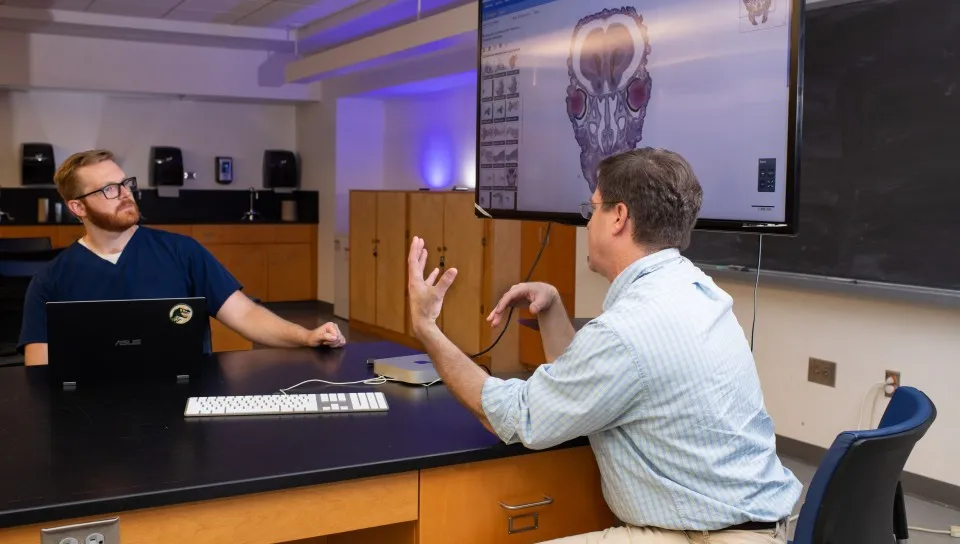
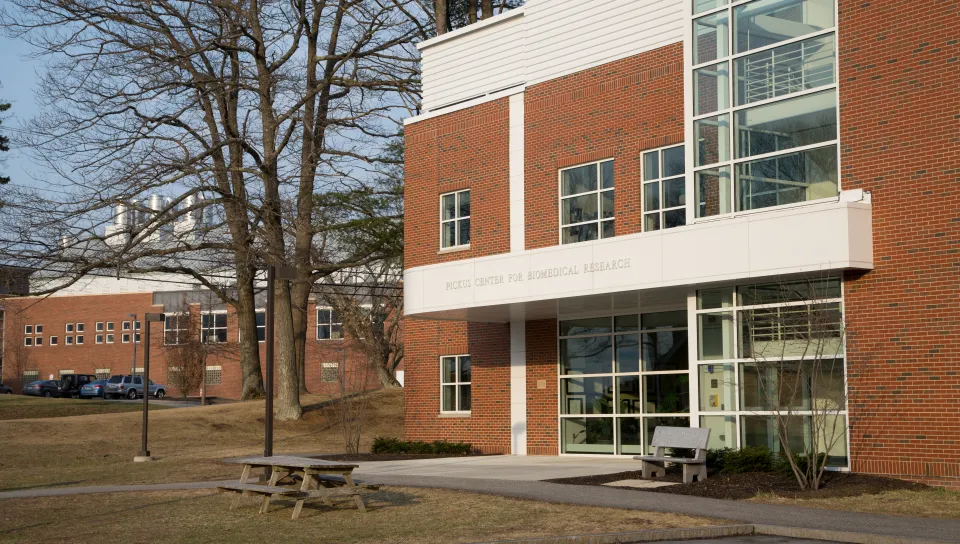
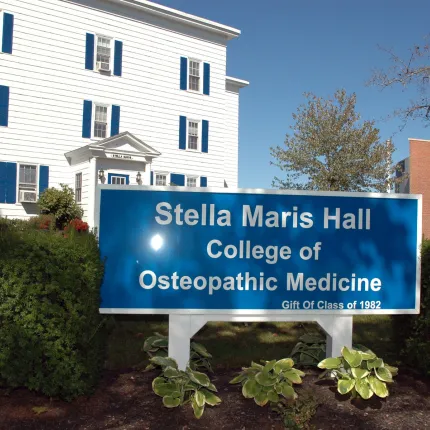
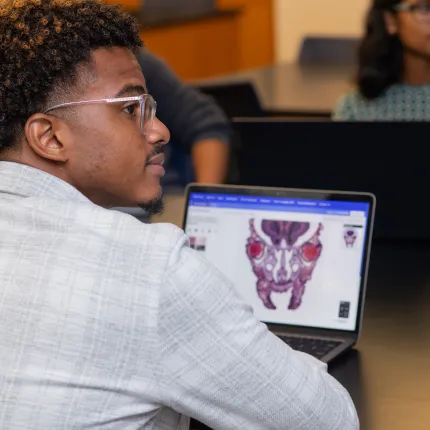
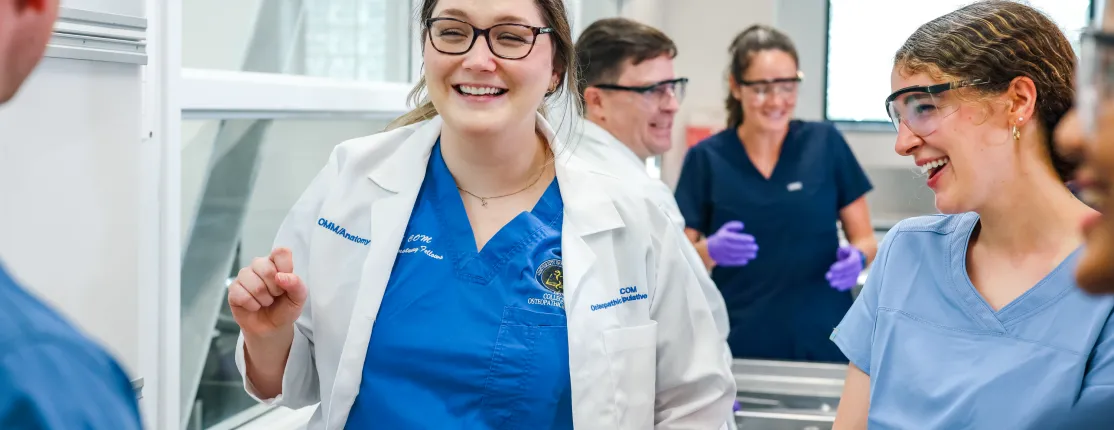
Potential Career Paths for Clinical Anatomy degree grads
Completion of the two-year M.S. in Clinical Anatomy can lead directly to positions in the medical field.
- The Research track can lead to lab work in higher education or pharmaceutical/biotechnology sectors. Your work published in peer-reviewed manuscripts will be invaluable to the medical field.
- The Teaching track positions you to teach others through their own anatomy education. Medical schools need anatomy educators, and you’ll be prepared to enter the workforce and make a difference.
- The one-year Clinical Anatomy Certificate amplifies your resume for admission to medical school. You’ll have successfully completed one year of anatomy education within our College of Osteopathic Medicine’s D.O. program, side-by-side with current medical students.
Clinical Anatomy Degree Facilities
Donor Anatomy Lab
The M.S. in Clinical Anatomy program is centered around UNE’s Donor Anatomy Lab — the only lab of its kind in southern Maine. Here, you will learn to develop an understanding of human structure and function at the gross anatomical level. This state-of-the-art facility has five pods with cutting-edge equipment. While in the donor lab, you will have the opportunity to prepare and demonstrate demo dissections (prosections), assist medical students in dissections, create and deliver didactics, and assist in student assessment and grading (under the guidance of the faculty).
Pickus Center for Biomedical Research
The Pickus Center for Biomedical Research is a state-of-the-art biomedical research building that houses research teams of UNE faculty and students.
The 22,000 sq. ft. structure enables you to engage in important research as part of your curriculum, build upon the strong base of research at UNE COM, and create opportunities for collaborative research. The center includes multiple laboratories, 12 faculty offices, two conference rooms, and a lab tech office suite.
Take a virtual tour of Pickus Center
Center for Pain Research
The Center for Pain Research supports a vibrant and collaborative neuroscience research program at UNE. The goal of the center is to increase the scientific understanding of the neurobiology of chronic pain, facilitating the discovery and development of novel therapies. M.S. in Clinical Anatomy (research track) candidates will have the opportunity to participate in research projects in the center.
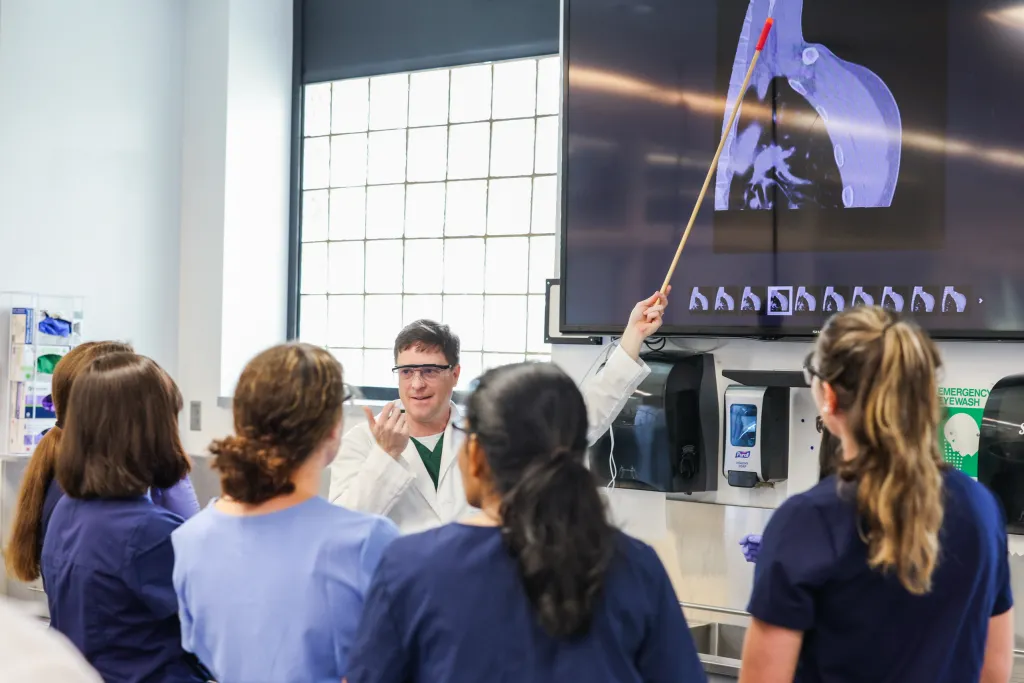

Hands-On Learning Outcomes
The M.S. in Clinical Anatomy program will prepare you with hands-on lab experience as well as teaching and learning opportunities with medical and other health professions students. Upon completion of the program, you will have an advanced:
- Understanding of human anatomy, embryology, histology, and physiology with special emphasis on knowledge relevant to health professionals.
- Anatomical knowledge as it relates to clinical imaging studies including fluoroscopy, radiology, CT scans, MRI, venous and arterial studies, cardiac studies, etc.
- Expertise in teaching donor dissection/prosection and assessing learning among health profession students and health professionals (two-year M.S. Anatomy Program – teaching track).
- Interpersonal and interprofessional skills (such as student-staff and peer communication), peer-active teamwork, and collaborative leadership, thereby fostering, identifying, and practicing the professional behavior(s) expected within the healthcare setting.
- Hypothesis formulation, experimental design/methods, data/statistical analysis, and dissemination of results through participation in research (two-year M.S. Anatomy program – research track).
- Understanding of research and being able to communicate outcomes through various biomedical communication strategies, including but not limited to peer-reviewed publications, posters, and presentations (two-year M.S. Anatomy program – research track).
- As a student of the research track, you will be assigned collaborative projects with faculty on funded research to solve real-world problems.
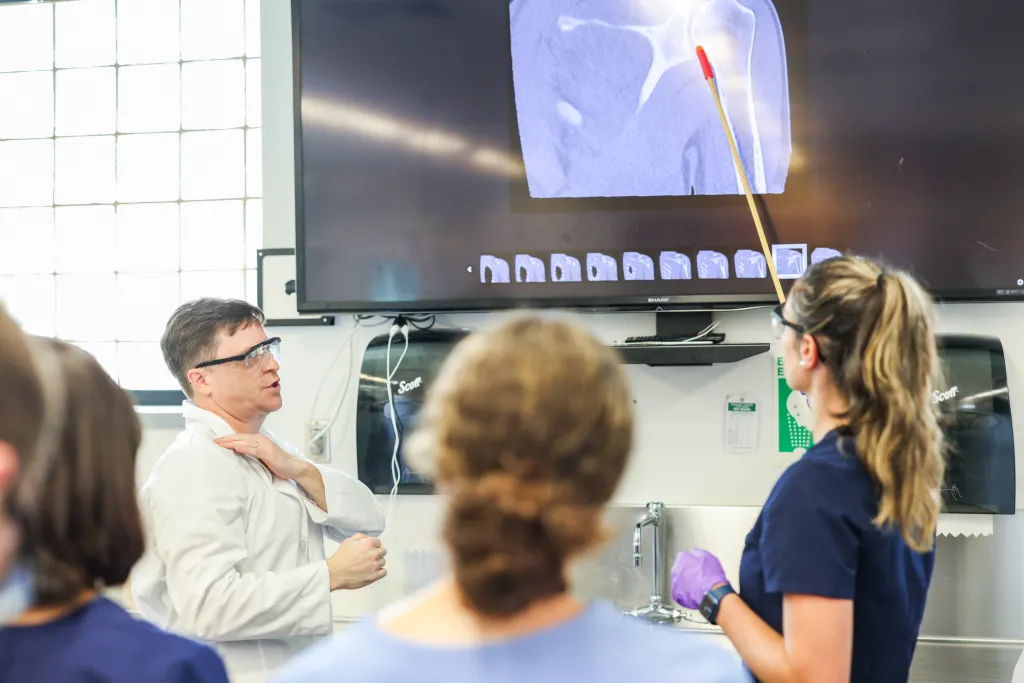
Clinical Anatomy: Team-Based Learning
When students from two or more disciplines learn with, from, and about each other to better understand different professional roles and expertise, great things can happen. As a student in the clinical anatomy program, you will be studying alongside students from other programs including the Doctor of Osteopathic Medicine, the Doctor of Dental Medicine, and beyond.
UNE is proud to be the only institution in New England that is part of the National Center for Interprofessional Education and Practice’s prestigious Innovation Network.
Living and Learning in Maine
As a student in our M.S. in Clinical Anatomy program, you will primarily study on our Portland Campus, which is home to the UNE College of Osteopathic Medicine, with occasional learning experiences on our scenic coastal Biddeford Campus. Our Portland Campus for the Health Sciences is located in a quiet neighborhood that is a 10-minute drive from the downtown waterfront. The campus is close to major clinical sites as well as countless attractions and amenities. Named “America’s Most Livable City” by Forbes and “Foodiest Small Town in America” by Bon Appetit, Portland is the city on every list.
In Biddeford, the waters of the Saco River flow into the Atlantic Ocean. Recently named the youngest city in Maine, Biddeford boasts an up-and-coming, hip downtown offering delicious eateries, exciting social and cultural events, and more.


Who Can Apply to the Clinical Anatomy Program?
To apply to our Clinical Anatomy degree program, you must hold a bachelor’s degree from a U.S. regionally accredited institution or international equivalent.
Financial Aid at UNE
Finance your education through loans, grants, and scholarships. We are committed to making our clinical anatomy degree program as affordable as possible.
Apply Today
Ready to begin your future in UNE’s Clinical Anatomy program?
Master's in Clinical Anatomy FAQ
What is a master’s in clinical anatomy?
Students participating in an M.S. in clinical anatomy program will be knowledgeable in detailed human anatomy, embryology, histology, imaging, and physiology. Graduates will have advanced anatomical knowledge particularly as it relates to clinical imaging including fluoroscopy, radiology, CT scans, MRI, venous and arterial studies, cardiac studies, and more.
As a student at UNE’s M.S. in Clinical Anatomy degree program, you will have hands-on training through our state-of-the-art donor lab where you will learn from our high-profile teaching and research faculty.
What can you do with a master’s in anatomy?
Anatomy expertise can lead to a variety of jobs with promising salaries and career benefits. Whether it’s teaching, research, or continuing your education in medical school, an M.S. in clinical anatomy can lead the way to many different rewarding careers in the medical industry.
At UNE, the Master’s in Clinical Anatomy program offers two pathways that support a diversity of career goals. These programs include:
- Teaching: Two-year Master of Science (M.S.) in Clinical Anatomy degree program with a focus on teaching anatomy
- Research: Two-year Master of Science (M.S.) in Clinical Anatomy degree program with a primary focus on research
The Teaching track ensures you’re well positioned for employment upon graduation. Medical schools need anatomy educators, and you’ll be more than prepared to enter the workforce and start making a difference.
The Research track can lead to working in a lab setting in higher education or pharmaceutical/biotechnology sectors. Your work published in peer-reviewed manuscripts will be invaluable to the medical field.
Earning your M.S. in clinical anatomy will also position you for other careers in the healthcare industry which might include working as a medical imaging specialist, medical illustrator, or as an anatomy lab manager/coordinator/diener or an autopsy technician within a medical examiner’s (coroner’s) office. You could also obtain many of these healthcare industry careers by completing UNE’s Graduate Certificate in Clinical Anatomy.
What is the best clinical anatomy master’s program for me?
When searching for a clinical anatomy master’s program, look for one that suits your future needs. Are you interested in a career in anatomical research or teaching? Programs such as the UNE’s M.S. in Clinical Anatomy specialize in those fields.
Are you continuing to medical school? An M.S. in Clinical Anatomy or a one-year graduate certificate can boost your prospects of acceptance and prepare you for your future career.
UNE offers three clinical anatomy program tracks. The three tracks include:
- One-year graduate certificate program
- Two-year M.S. degree in Clinical Anatomy with a focus on teaching anatomy
- Two-year M.S. degree in Clinical Anatomy with a focus on research
Who is a master’s in anatomy program meant for?
An M.S. in clinical anatomy provides advanced training in human anatomy. You will gain the knowledge and skills to apply, communicate, and teach that knowledge to the next generation of physicians.
With a master’s degree in anatomy, you will be prepared to enter medical careers in academic teaching, research, or additional graduate/doctorate programs for further specialized education.
The Clinical Anatomy master’s degree program at UNE incorporates our existing curriculum within the College of Osteopathic Medicine (COM), as well as newly developed learning experiences to prepare you for a rewarding career in research or medical school education.
How much do professionals with a master’s in anatomy make?
The salaries associated with a master’s degree in clinical anatomy will depend on the type of field and position you go into. Some graduate students will use a master’s in anatomy as a springboard to a terminal degree, so salaries for anatomy graduates can vary greatly. Below are five examples of careers and salaries, according to ziprecruiter.com, where a master’s of anatomy can be valuable:
- Research Scientist — $96,131
- Physician Assistant — $95,172
- Human Anatomy Professor — $92,514
- Operating Room Nurse — $71,425
- Pharmaceutical Sales Representative — $70,106
